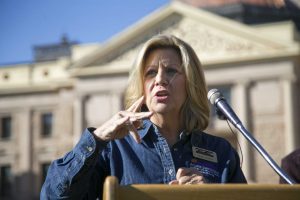- Slug: BC-CNS Deaf Accessibility, 900 words.
- 1 photo and caption below.
By Haley Lorenzen
Cronkite News
PHOENIX – For many people who are deaf or hard of hearing, lip reading, facial expressions and body language are vital to communication, but protective face masks and remote work and school meant to slow the spread of COVID-19 have made it more difficult.
More than 1.1 million people in Arizona are hard of hearing, and more than 20,000 are deaf, according to the Arizona Commission for the Deaf and Hard of Hearing.
“That’s a large percent of us in the state,” said the commission’s executive director, Sherri Collins. “You think about communication, and why it’s so important that information and access is critical for that 1.1 million people that we serve.”
Collins, who is deaf, has served 22 years as the executive director of the state commission, which works with organizations throughout the state to provide services for people who are deaf, deaf-blind or hard of hearing. The commission also oversees the licensing of American Sign Language interpreters.
Commission staff members have transitioned to a fully remote work environment, Collins said, and the change has worked out well for the staff, with Zoom meetings, interpreters and captioning.
“The only thing that’s lacking is the interaction with the face-to-face,” she said.
However, the transition for other deaf individuals has been more challenging.
Ronda Moriarty is an ASL instructor who has taught at Arizona State University, Mesa Community College and Phoenix College. She also works as an ASL Master for Netflix.
“The internet is great to have; it was very beneficial when teaching my class. But teaching a class with 11 or more people on the computer was really hard,” she said.
“There were students trying to take the class on their phones, but because it’s so small on the screen it’s hard for them to see and it was very distracting. They had to put the phone down to sign and it would fall over, however, they did the best they could with what they had,” Moriarty said.
For those who use sign language, facial expressions are essential for proper communication. Sign meanings can change depending on the type of facial expression, such as exaggeration.
Melissa “Echo” Greenlee is the founder of deaffriendly.com, an online resource where people who are deaf, deaf-blind or hard of hearing provide input for local businesses in order to increase deaf-friendliness.
“Now, many states are requiring people in businesses to have a mask,” Greenlee said. “So that means when we go into a business, we feel there’s a barrier. It’s very tough emotionally because some of us have trained ourselves for 20, 30 or 40 years to read people.
“Now, my area in Washington state started opening, but I don’t want to go out because I know I have to deal with the masks and that’s a barrier. I’d rather just stay home.”
Some companies, such as ClearMask, are making clear face masks which are said to be “antifogging.” Hundreds of clear masks also are available on sites such as Etsy or Facebook Marketplace. However, most such masks are imperfect.
“Clear masks are a great idea,” Moriarty said. “I know someone who could make clear masks, but they said it’s hard to breathe with the plastic and difficult to read lips as the steam will rise in the mask.”
Greenlee said many deaf people also lack access to important public health information.
“Access to media, for example, the news,” she said. “Every day, there’s a person on the news explaining what’s going on in the state, how many people have died today, et cetera, but if a deaf person doesn’t have access to an ASL interpreter and captioning, there’s a huge part of the population without access to that information.”
Under the 30-year-old Americans With Disabilities Act, effective communication, which often includes interpreters, is required for deaf or hard of hearing people in a hospital setting.
Despite the law, interpreters often are missing from important news conferences. In March, the National Association for the Deaf wrote a letter to the White House expressing concern about the lack of an ASL interpreter at public COVID-19 briefings.
“From the first White House press conference on this coronavirus, the NAD has received daily complaints from deaf and hard of hearing citizens across the country asking why their President is not ensuring they are getting the same access to emergency information as everyone else,” wrote Howard A. Rosenblum, the association’s chief executive officer.
In April, New York Gov. Andrew Cuomo was sued for not providing an ASL interpreter during his televised briefings.
“Some states do a good job with providing an interpreter and captioning,” Greenlee said, “but other states have been slower to respond. Still today, the president doesn’t have an ASL interpreter.”
The deaf community is very social, she said, which means isolation can be another big challenge.
“We get together a lot. With the stay-at-home order, some of us are alone. Some of us live with hearing people who sign or don’t sign, some of us are having a hard time with that isolation.”
Even so, some in the deaf community have turned to video conferencing apps for social events.
“It can be hard for friends to get together,” Moriarty said, “but we had Zoom get-togethers. We had a few happy hours, had some drinks. One good thing about Zoom happy hour is no one is drinking and driving, right? So that’s good!”
For more stories from Cronkite News, visit cronkitenews.azpbs.org.
^_=
